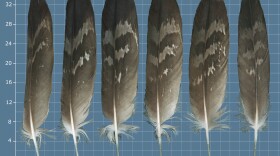
Diane Hope
Diane Hope, Ph.D., is a former ecologist and environmental scientist turned audio producer, sound recordist and writer. Originally from northern England, she has spent much of the last 25 years in Arizona and has been contributing scripts to Earth Notes for 15 years.
-
A new study on the condor has revealed fundamental new insights into the lives of these critically endangered bird of prey.
-
As winter sets in, rodents seek warmth and food — often in our homes. There are non-toxic ways to control them, from rodent birth control to attracting natural predators.
-
The 64-mile steam train service from Williams to the South Rim of the Grand Canyon began in 1901, when a ticket cost $3.95. An updated, eco-friendly version is still in use today.
-
New research in New Mexico shows that black bears thrive in forests renewed by fire — especially when it means more berries, acorns and cover.
-
A creature inhabits northern Arizona that has every appearance of a diminutive rhinoceros.
-
After sunset, the eerie choruses of coyotes are among the most iconic sounds of the American West.
-
Fire lookout towers didn't exist in Arizona in the early 1900s. Instead, firefighters use tall ponderosa pines near mountain tops or other strategic viewpoints.
-
If you find a bird feather – how can you tell which species it belongs to? An ornithologist in the Forensic Laboratory at the U.S. Fish and Wildlife Service pondered this question.
-
Wet meadows are small but crucial landscape elements among the pines above the Mogollon Rim. They benefit plant diversity, wildlife and watershed health.
-
Monarch Butterflies fly thousands of miles every year between their southern overwintering grounds as far north as Canada and back.











